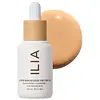What's inside
What's inside
 Key Ingredients
Key Ingredients

 Benefits
Benefits

 Concerns
Concerns

 Ingredients Side-by-side
Ingredients Side-by-side

Zinc Oxide 12%
Cosmetic ColorantWater
Skin ConditioningSqualane
EmollientShea Butter Ethyl Esters
EmollientIsoamyl Laurate
EmollientPolyglyceryl-3 Ricinoleate
EmulsifyingButyloctyl Salicylate
Skin ConditioningPropanediol
SolventIsopropyl Isostearate
EmollientPolyglyceryl-3 Diisostearate
EmulsifyingMethylpropanediol
SolventNiacinamide
SmoothingSodium Chloride
MaskingLecithin
EmollientCaprylyl Glycol
EmollientSilica
AbrasiveAloe Barbadensis Leaf Juice Powder
Skin ConditioningBisabolol
MaskingHydrolyzed Sodium Hyaluronate
Skin ConditioningAllantoin
Skin ConditioningPhenylpropanol
MaskingSodium Myristoyl Glutamate
CleansingSodium Hyaluronate
HumectantTetrasodium Glutamate Diacetate
Aluminum Hydroxide
EmollientPolyhydroxystearic Acid
EmulsifyingCI 77491
Cosmetic ColorantCI 77492
Cosmetic ColorantCI 77499
Cosmetic ColorantTitanium Dioxide
Cosmetic ColorantZinc Oxide 12%, Water, Squalane, Shea Butter Ethyl Esters, Isoamyl Laurate, Polyglyceryl-3 Ricinoleate, Butyloctyl Salicylate, Propanediol, Isopropyl Isostearate, Polyglyceryl-3 Diisostearate, Methylpropanediol, Niacinamide, Sodium Chloride, Lecithin, Caprylyl Glycol, Silica, Aloe Barbadensis Leaf Juice Powder, Bisabolol, Hydrolyzed Sodium Hyaluronate, Allantoin, Phenylpropanol, Sodium Myristoyl Glutamate, Sodium Hyaluronate, Tetrasodium Glutamate Diacetate, Aluminum Hydroxide, Polyhydroxystearic Acid, CI 77491, CI 77492, CI 77499, Titanium Dioxide
Water
Skin ConditioningDimethicone
EmollientTalc
AbrasiveDicaprylyl Carbonate
EmollientIsostearyl Neopentanoate
EmollientPEG-10 Dimethicone
Skin ConditioningDimethicone/Vinyl Dimethicone Crosspolymer
Skin ConditioningGlycerin
HumectantTrimethylsiloxysilicate
EmollientIsododecane
EmollientBis-PEG/PPG-14/14 Dimethicone
EmollientPhenoxyethanol
PreservativeSodium Chloride
MaskingDimethicone Crosspolymer
Emulsion StabilisingMagnesium Sulfate
Hydrogen Dimethicone
Sodium Dehydroacetate
PreservativeTrehalose
HumectantUrea
BufferingPotassium Sorbate
PreservativeSilica
AbrasiveDisteardimonium Hectorite
StabilisingAluminum Hydroxide
EmollientBenzoic Acid
MaskingSodium Hyaluronate
HumectantC24-28 Alkyl Methicone
EmollientPentylene Glycol
Skin ConditioningSerine
MaskingDehydroacetic Acid
PreservativePropylene Carbonate
SolventEthylhexylglycerin
Skin ConditioningAlgin
MaskingCaprylyl Glycol
EmollientDisodium Phosphate
BufferingGlyceryl Polyacrylate
Pullulan
Tocopherol
AntioxidantPotassium Phosphate
BufferingIron Oxides
CI 77891
Cosmetic ColorantWater, Dimethicone, Talc, Dicaprylyl Carbonate, Isostearyl Neopentanoate, PEG-10 Dimethicone, Dimethicone/Vinyl Dimethicone Crosspolymer, Glycerin, Trimethylsiloxysilicate, Isododecane, Bis-PEG/PPG-14/14 Dimethicone, Phenoxyethanol, Sodium Chloride, Dimethicone Crosspolymer, Magnesium Sulfate, Hydrogen Dimethicone, Sodium Dehydroacetate, Trehalose, Urea, Potassium Sorbate, Silica, Disteardimonium Hectorite, Aluminum Hydroxide, Benzoic Acid, Sodium Hyaluronate, C24-28 Alkyl Methicone, Pentylene Glycol, Serine, Dehydroacetic Acid, Propylene Carbonate, Ethylhexylglycerin, Algin, Caprylyl Glycol, Disodium Phosphate, Glyceryl Polyacrylate, Pullulan, Tocopherol, Potassium Phosphate, Iron Oxides, CI 77891
 Reviews
Reviews

Ingredients Explained
These ingredients are found in both products.
Ingredients higher up in an ingredient list are typically present in a larger amount.
Aluminum Hydroxide is a form of aluminum. It can be naturally found in nature as the mineral gibbsite. In cosmetics, Aluminum Hydroxide is used as a colorant, pH adjuster, and absorbent.
As a colorant, Aluminum Hydroxide may add opacity, or reduce the transparency. Aluminum hydroxide is contains both basic and acidic properties.
According to manufacturers, this ingredient is an emollient and humectant. This means it helps hydrate the skin.
In medicine, this ingredient is used to help relieve heartburn and help heal ulcers.
There is currently no credible scientific evidence linking aluminum hydroxide in cosmetics to increased cancer risk.
Major health organizations allow the use of aluminum hydroxide in personal care products and have not flagged it as a carcinogenic risk at typical usage levels.
Learn more about Aluminum HydroxideCaprylyl Glycol is a humectant and emollient, meaning it attracts and preserves moisture.
It is a common ingredient in many products, especially those designed to hydrate skin. The primary benefits are retaining moisture, skin softening, and promoting a healthy skin barrier.
Though Caprylyl Glycol is an alcohol derived from fatty acids, it is not the kind that can dry out skin.
This ingredient is also used as a preservative to extend the life of products. It has slight antimicrobial properties.
Learn more about Caprylyl GlycolSilica, also known as silicon dioxide, is a naturally occurring mineral. It is used as a fine, spherical, and porous powder in cosmetics.
Though it has exfoliant properties, the function of silica varies depending on the product.
The unique structure of silica enhances the spreadability and adds smoothness, making it a great texture enhancer.
It is also used as an active carrier, emulsifier, and mattifier due to its ability to absorb excess oil.
In some products, tiny microneedles called spicules are made from silica or hydrolyzed sponge. When you rub them in, they lightly polish away dead skin layers and enhance the penetration of active ingredients.
Learn more about SilicaChances are, you eat sodium chloride every day. Sodium Chloride is also known as table salt.
This ingredient has many purposes in skincare: thickener, emulsifier, and exfoliator.
You'll most likely find this ingredient in cleansers where it is used to create a gel-like texture. As an emulsifier, it also prevents ingredients from separating.
There is much debate on whether this ingredient is comedogenic. The short answer - comedogenic ratings don't tell the whole story. Learn more about comegodenic ratings here.
The concensus about this ingredient causing acne seems to be divided. Research is needed to understand if this ingredient does cause acne.
Scrubs may use salt as the primary exfoliating ingredient.
Learn more about Sodium ChlorideSodium Hyaluronate is hyaluronic acid's salt form. It is commonly derived from the sodium salt of hyaluronic acid.
Like hyaluronic acid, it is great at holding water and acts as a humectant. This makes it a great skin hydrating ingredient.
Sodium Hyaluronate is naturally occurring in our bodies and is mostly found in eye fluid and joints.
These are some other common types of Hyaluronic Acid:
Learn more about Sodium HyaluronateWater. It's the most common cosmetic ingredient of all. You'll usually see it at the top of ingredient lists, meaning that it makes up the largest part of the product.
So why is it so popular? Water most often acts as a solvent - this means that it helps dissolve other ingredients into the formulation.
You'll also recognize water as that liquid we all need to stay alive. If you see this, drink a glass of water. Stay hydrated!
Learn more about Water